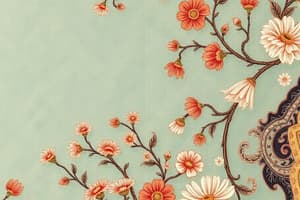Podcast
Questions and Answers
What are metallic fibers made of?
What are metallic fibers made of?
- Cotton, polyester, nylon, and silk
- Wool, linen, jute, and hemp
- Metal, plastic-coated metal, metal-coated plastic, or a core material covered by metal (correct)
- Wood, glass, carbon, and ceramic
How can metallic filaments be protected from tarnishing?
How can metallic filaments be protected from tarnishing?
- By coating them with transparent films, often polyester (correct)
- By leaving them uncovered
- By immersing them in water
- By exposure to sunlight
What is a method used in textile recycling to reduce fabric waste?
What is a method used in textile recycling to reduce fabric waste?
- Burning fabric scraps
- Dumping fabric scraps in water bodies
- Converting fabric scraps to fiber and spinning them into new yarn (correct)
- Throwing fabric scraps in landfills
Which of the following is not a fabrication method for textiles mentioned in the text?
Which of the following is not a fabrication method for textiles mentioned in the text?
In which century did textile looms like the one in Lowell, Massachusetts originate?
In which century did textile looms like the one in Lowell, Massachusetts originate?
"Closed-loop processes" mentioned in the text refer to processes that:
"Closed-loop processes" mentioned in the text refer to processes that:
What is the process of producing vinyl wallcoverings?
What is the process of producing vinyl wallcoverings?
Which material is commonly used to make simulated leather?
Which material is commonly used to make simulated leather?
In textile manufacturing, what is the purpose of combining manufacturing techniques in composite fabrics?
In textile manufacturing, what is the purpose of combining manufacturing techniques in composite fabrics?
Which weaving technique involves interlocking metal links formed from rings of solid brass or stainless steel?
Which weaving technique involves interlocking metal links formed from rings of solid brass or stainless steel?
How are colors primarily added to textiles in the dyeing and printing process?
How are colors primarily added to textiles in the dyeing and printing process?
What is the main objective of textile recycling?
What is the main objective of textile recycling?
What is the main difference between solution dyeing and direct printing in the context of textile manufacturing?
What is the main difference between solution dyeing and direct printing in the context of textile manufacturing?
What distinguishes discharge printing from resist printing techniques in textile design?
What distinguishes discharge printing from resist printing techniques in textile design?
Which of the following statements accurately describes leather tanning?
Which of the following statements accurately describes leather tanning?
What makes leather a durable material for various applications?
What makes leather a durable material for various applications?
Which textile printing process involves adding colored pigments or dyes to the solution from which the fiber is spun?
Which textile printing process involves adding colored pigments or dyes to the solution from which the fiber is spun?
What distinguishes resist printing from other textile printing methods?
What distinguishes resist printing from other textile printing methods?
Flashcards are hidden until you start studying




